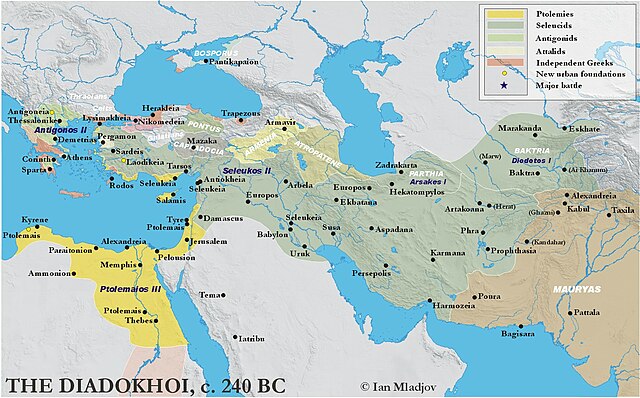Lysimachus was a Thessalian officer and successor of Alexander the Great, who in 306 BC, became King of Thrace, Asia Minor and Macedon.
Hellenistic marble bust of Lysimachus at the Ephesus Archaeological Museum, dated circa 300 BC.
A marble bust of Lysimachus, an Augustan Roman era copy of a Hellenistic Greek original dated to the 2nd century BC, National Archaeological Museum, Naples
Obverse of coin of Lysimachus: The horned Alexander appears as the king's divine patron.
Tetradrachm of Lysimachus. The Greek inscription reads: ΒΑΣΙΛΕΩΣ ΛΥΣΙΜΑΧΟΥ "[coin] of King Lysimachus".
The Diadochi were the rival generals, families, and friends of Alexander the Great who fought for control over his empire after his death in 323 BC. The Wars of the Diadochi mark the beginning of the Hellenistic period from the Mediterranean Sea to the Indus River Valley.
Bust of Seleucus I Nicator ("Victor"; c. 358 – 281 BC), the last of the original Diadochi.
Alexander the Great and Craterus in a lion hunt, mosaic from Pella, Greece, late 4th century BC
Paintings of ancient Macedonian soldiers, arms, and armaments, from the tomb of Agios Athanasios, Thessaloniki in Greece, 4th century BC
Hellenistic kingdoms as they existed in 240 BC, eight decades after the death of Alexander the Great




![Tetradrachm of Lysimachus. The Greek inscription reads: ΒΑΣΙΛΕΩΣ ΛΥΣΙΜΑΧΟΥ "[coin] of King Lysimachus".](https://upload.wikimedia.org/wikipedia/commons/thumb/b/b7/Lysimachus.jpg/298px-Lysimachus.jpg)



